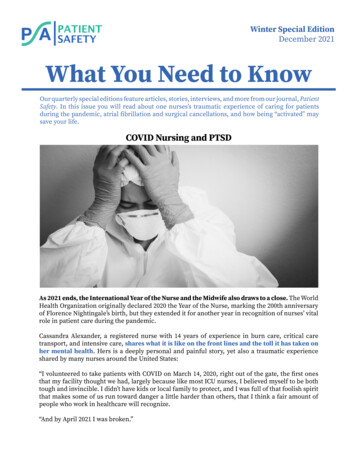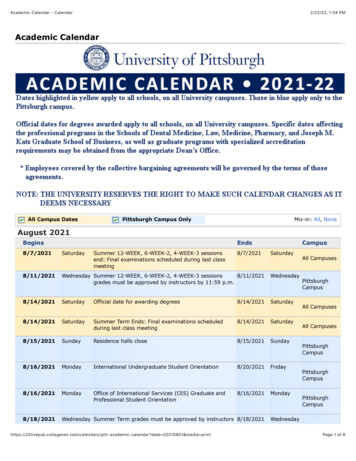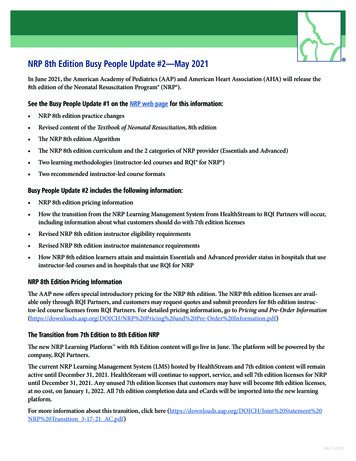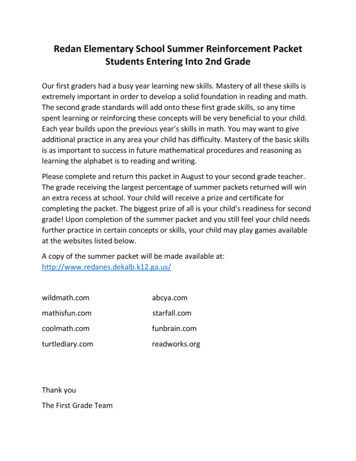
Transcription
Winter Special EditionDecember 2021What You Need to KnowOur quarterly special editions feature articles, stories, interviews, and more from our journal, PatientSafety. In this issue you will read about one nurses’s traumatic experience of caring for patientsduring the pandemic, atrial fibrillation and surgical cancellations, and how being “activated” maysave your life.COVID Nursing and PTSDAs 2021 ends, the International Year of the Nurse and the Midwife also draws to a close. The WorldHealth Organization originally declared 2020 the Year of the Nurse, marking the 200th anniversaryof Florence Nightingale’s birth, but they extended it for another year in recognition of nurses’ vitalrole in patient care during the pandemic.Cassandra Alexander, a registered nurse with 14 years of experience in burn care, critical caretransport, and intensive care, shares what it is like on the front lines and the toll it has taken onher mental health. Hers is a deeply personal and painful story, yet also a traumatic experienceshared by many nurses around the United States:“I volunteered to take patients with COVID on March 14, 2020, right out of the gate, the first onesthat my facility thought we had, largely because like most ICU nurses, I believed myself to be bothtough and invincible. I didn’t have kids or local family to protect, and I was full of that foolish spiritthat makes some of us run toward danger a little harder than others, that I think a fair amount ofpeople who work in healthcare will recognize.“And by April 2021 I was broken.”
Original Articles — Perioperative Delirium/Agitation Associated With theUse of AnestheticsEmergence delirium—an altered mental state resulting from an anesthetic—posesrisks to the patient and staff. During the bout of delirium/agitation, the patient mayact violently (including punching, kicking, hitting, or biting), show aggression orcombativeness, scream, disconnect with current time and place, attempt to removemedical apparatuses, or engage in other harmful behavior. What do we know aboutthe causes and what can we do to prevent it?To answer these questions, researchers turned to the Pennsylvania Patient SafetyReporting System (PA-PSRS). They examined 97 event reports of bouts of deliriumand agitation associated with anesthetics and/or adjunct agents that occurred before,during, and after an operation. Their deep dive into the data revealed novel insightsinto how delirium and agitation have varying safety implications depending on theoperative period.Incorporating best practices of the 63 facilities included in this study, existingliterature, and guidelines from the VA Pittsburgh Healthcare System, the authors alsodeveloped an intervention package to prevent, treat, and de-escalate bouts of deliriumand agitation. Highlights of this resource include three strategies (patient restraint,readministration of an anesthetic and/or adjunct agent, and call for additional staff),as well as four key phases: patient evaluation with individualized plan, preoperativeactions, intraoperative actions, and postoperative actions.December 20212
Benzodiazepines Opioids: A Risky CombinationEvery medication has associated risks, but what happens when they’re usedin combination? In particular, guidelines discourage using benzodiazepines inconjunction with opioid pain medications in older adults—so is it still happening,how often does it occur, and what are the consequences for geriatric patients?Researchers examine the risks that are created when these drugs are administeredtogether in the hospital, including an increased risk of overdose. They identified 80reports from the Pennsylvania Patient Safety Reporting System (PA-PSRS) in which apatient may have experienced an adverse drug reaction (ADR) to the combined use ofa benzodiazepine and an opioid pain medication.They determined that changes in mental status were the most common ADRs,occurring in more than two-thirds of reports, followed by respiratory reactions(51.3%) and cardiovascular reactions (25.0%). In 70% of reports, the patient receiveda reversal agent, either flumazenil or naloxone, or both. The inappropriate use ofbenzodiazepines and opioid pain medications in combination among patients 65years and older is a growing problem, and an increased awareness may be the firststep for providers to begin addressing it.FOLLOW THE PSA ON@PATIENTSAFETYAUTHORITYDecember 20213
Atrial Fibrillation and Surgical CancellationsAtrial fibrillation (AF or “AFib”) is the most common cardiac arrhythmia, manifestedby the heart beating too slowly, too fast, or in an irregular way. People with AFcan be symptomatic or asymptomatic and are at increased risk for stroke. AF alsopresents patient safety concerns for ambulatory surgical facilities (ASFs)—resultingin cancellations, transfers, or providing additional services to complete a procedure,which may disrupt workflow processes.Researchers surveyed 322 Pennsylvania ASFs in March 2021 and completed afive-year study of Pennsylvania Patient Safety Reporting System (PA-PSRS) reportsidentifying new-onset AF, in order to examine the impact of AF on surgical facilitiesand identify opportunities for improvement. Among their discoveries: Cardiacarrhythmia was the most frequently identified reason for a transfer, and nearly60% of respondents identified medical issues missed/identified during preoperativescreening as one of the top four reasons for cancellations in their facility. More than86% of the patients with new-onset AF were asymptomatic, and most were identifiedduring the preoperative phase. For this reason, preoperative screening may identifypatients at risk for AF.Based on the results of the analysis and review of the literature, researchers identifiedareas of opportunity for future improvement broadly and at the facility level. Twoareas for future research include screening for new-onset AF using smart devices andnurse-driven preoperative screening processes.December 20214
2020 Pennsylvania Patient Safety Reporting: Updated Acute CareReporting RatesIn the recent Patient Safety Authority summary of 2020 data from acute carefacilities in Pennsylvania, reporting rates and fall rates were provided for Q1 and Q22020 based on the latest data available at the time of publication, June 2020. This datasnapshot completes the reporting rates for 2020 now that all hospital patient daysand surgical encounters data from 2020 have made available for rate calculations.Data and a New Tool to Detect Urinary Tract InfectionsUrinary tract infections (UTIs) are often treated in long-term care (LTC) facilities,but they’re notoriously difficult to diagnose. To better understand the reasons andrisks for residents, researchers studied the patient safety event reports and sharethe trends in rates and most common types of infections, as well as a toolkit theydeveloped to help reduce the occurrence UTIs and promote antibiotic stewardship.Their analysis shows that despite regulations to improve infection prevention practicesand decreased use of urinary indwelling catheters, the rates of UTIs continued torise from 2016 to 2020, and pose a significant threat of morbidity and mortality forresidents of LTC facilities as well as diagnostic and treatment challenges for providers.They encourage patient safety officers, administrators, and infection preventioniststo share their toolkit of best practices for UTI prevention with frontline staff, nursing,pharmacy, and laboratory management. It includes indications, insertion, andmaintenance practices for use of indwelling urinary catheters; recommendations toprevent overtreatment of UTIs; and antibiotic stewardship practices that may helpto reduce long-term resident harm associated with UTIs, overuse of antibiotics, andadverse effects of antibiotics.Perspectives — Mother Knows BestThe good news: We’re living longer. The bad news: Longevity increases the likelihoodof developing geriatric syndromes, such as falls, delirium, dementia, sleep disorders,and weight loss. Author Richard Kundravi shares how his mother’s lifestyle helpedher avoid many of these problems associated with aging.“As the son of a fiercely independent woman who lived well into her 10th decade,I had the privilege of observing firsthand how important managing these commonconditions was for her staying self-sufficient. I am especially grateful for the lessonsmy mother taught me for staying healthy and happy.“My mom did not have a technical term for her approach to staying healthy but rathera focus that I classify as ‘My Mom’s 5 Ms for Staying Healthy,’ which, in no particularorder, are medication management, meal maintenance, mobility, mentation, andmoisture monitoring.”December 20215
How Being “Activated” May Save Your LifeStudies show patients who are more “activated” (i.e., invested in their care) aremore likely to have better outcomes. Dr. Judith H. Hibbard, researcher and professoremerita at the University of Oregon, explains what it means to be activated—andhow being so may just save your life:“Patient activation has a specific definition: an individual with the knowledge, skill, andconfidence to manage their health and their healthcare. They understand their rolein that process and feel capable of doing it. Patient engagement is a term that is usedto mean lots of different things. Sometimes they mean patient activation. Sometimesthey mean involving the patient in the care process, which is quite different than thepatient feeling some ownership and understanding their role and gaining the skillsand confidence that they need.”Activated patients have six characteristics that empower them to participate moreeffectively in their own care, with better outcomes, which include the ability to selfmanage their illness or health problems, the ability to collaborate with their healthcareproviders, and the ability to navigate the healthcare system.“The key is meeting people where they are,” Hibbard says. “If they are overwhelmedor have low confidence or a limited idea of what their role is in the care process, youwant to work with them differently than someone who’s being very proactive abouttheir health and wants to have a major role in their care.”Slow Down: New-Onset Atrial Fibrillation Challengers in Surgical CentersCancellations and transfers out of an ambulatory surgical facility (ASF) arereportable events under the Medical Care Availability and Reduction of Error(MCARE) Act, and present numerous challenges to the timely delivery of preventative,diagnostic, and elective care.Two researchers recently took a closer look at this problem, with a particular focuson the impact of new-onset atrial fibrillation (AF, commonly known as “AFib”)—the first diagnosis of a cardiac arrhythmia characterized by an irregular rhythm andoften rapid heart rate. Because AF poses a safety risk to surgical patients, the plannedprocedure often must be canceled or the patient must be transferred, resulting in adelay in treatment.As part of their investigation, the authors looked at data from the Pennsylvania PatientSafety Reporting System (PA-PSRS), completed a literature review, and interviewedstaff at three Pennsylvania ophthalmology and endoscopy centers about how theymanage patients with new-onset AF. Each facility had its own approach, includingaddressing hydration status, using a nurse-based preoperative screening process, andworking collaboratively with cardiologists and primary care physicians.December 20216
Letter to the Editor — On Simulation and Event ReportingIn response to the article “Comparison of Simulation-Only Versus Simulation PlusLive Training in Paracentesis” (Patient Safety, September 2021), authors weigh inon the benefits of in situ, team-based simulation for creating a safe environment inwhich to learn nontechnical skills (such as leadership, teamwork, and communication)and slowing skill and knowledge decay.The authors emphasize: “To achieve maximum benefit from a simulation-basedtraining module, it is essential to match the goals of the simulation module with theidentified clinical need. The clinical need varies depending on location and learnersinvolved but can encompass task training, process evaluation, or team training foreffective emergency responses.”An additional benefit: When such training uses data from event reporting systems todevelop training scenarios, it also promotes reporting as an important and helpfultool that aids in patient safety.The future of patient safetyeducation is here!Click here to check out our newonline learning system!Patient Safety Authority 333 Market Street, Lobby Level, Harrisburg, PA 17101patientsafety.pa.gov patientsafetyauthority@pa.govDecember 20217
Winter Special Edition December 2021 Our quarterly special editions feature articles, stories, interviews, and more from our journal, Patient Safety. In this issue you will read about one nurses’s traumatic experience of caring for patients during the pandemic, atrial fibrillation










